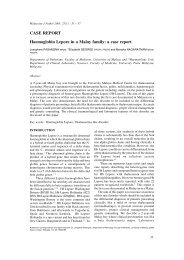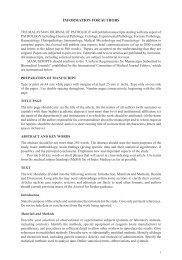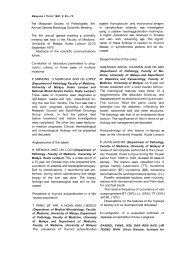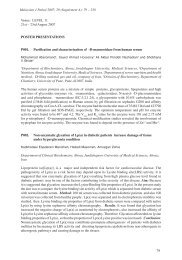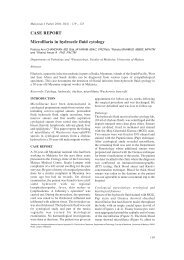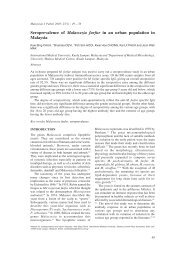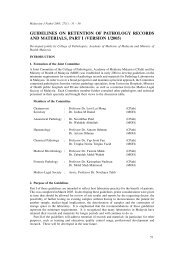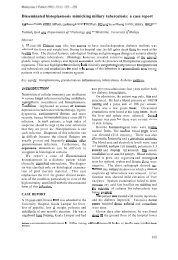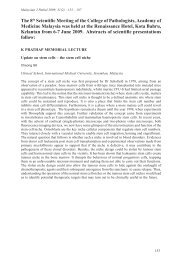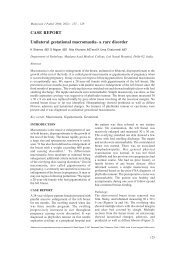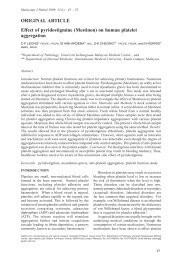Chediak-Higashi syndrome: a case report - MJPath
Chediak-Higashi syndrome: a case report - MJPath
Chediak-Higashi syndrome: a case report - MJPath
You also want an ePaper? Increase the reach of your titles
YUMPU automatically turns print PDFs into web optimized ePapers that Google loves.
Malaysian J Pathol June 2004<br />
are membrane-limited organelles that contain a<br />
variety of acid hydrolases. These structures are<br />
present in most cells and their function is related<br />
to intracellular digestion which includes the<br />
hydrolysis of extracellular material and under<br />
certain circumstances, hydrolysis of intracellular<br />
contents. Primary lysosomes may fuse with<br />
cytoplasmic vacuoles or phagosomes, forming<br />
secondary lysosomes that contain partially or<br />
completely digested materials. 18<br />
In <strong>Chediak</strong>-<strong>Higashi</strong> <strong>syndrome</strong>, the large<br />
granules within the neutrophils result from<br />
abnormal fusion of primary (azurophilic)<br />
granules with secondary (specific) granules. 19,20<br />
The fusion of the giant granules with phagosomes<br />
is delayed, contributing to the impaired<br />
immunity. 5,15 Almost all cells of a CHS patient<br />
show some aspect of the abnormal and<br />
dysmorphic lysosomes, storage granules, or<br />
related vesicular structures. For example, the<br />
melanosomes of melanocytes are oversized and<br />
delivery to the keratinocytes in the hair follicles<br />
is partly impaired. When examined<br />
microscopically, the hair shafts have a mixture<br />
of giant melanosomes alternating with small<br />
regions devoid of these pigment granules. This<br />
leads to the macroscopic impression of hair that<br />
is lighter than expected from parental colouration<br />
and has an irregular grayish-silver particulate<br />
sheen. The same defect in melanocytes results<br />
in partial ocular albinism with light sensitivity.<br />
There may be reduced dense bodies in platelets,<br />
which may explain the easy bruising and<br />
prolonged bleeding time found in some CHS<br />
patients. 12<br />
Treatment options for CHS patients are<br />
limited. Previously, the mainstay of treatment<br />
has been mainly symptomatic with antibiotics<br />
and Vitamin C 21 for bacterial infections and<br />
blood product replacement for bleeding<br />
complications. Subsequently when accelerated<br />
phase occurs, etoposide (VP-16), steroids and<br />
intrathecal methotrexate have been tried. Only<br />
recently has allogeneic bone marrow<br />
transplantation become a viable option for these<br />
patients. However, though transplantation has<br />
been shown to correct the haematologic and<br />
immunologic complications of CHS thus halting<br />
the inevitable grim prognosis, it has not been<br />
shown to reverse or prevent further neurological<br />
deficit. 12 This is probably because once the<br />
degenerative changes in the axons and myelin<br />
sheaths occur in the course of the disease, it<br />
cannot be reversed, they being permanent cells<br />
with no regenerative capacity. 14<br />
Since the diagnosis of CHS depends on the<br />
recognition of the characteristic abnormal giant<br />
granules present in the granulocytes in a<br />
peripheral blood film, we suggest that this is an<br />
essential investigation in all young children who<br />
are seen for frequent recurrent infections or who<br />
are suspected to have virus-associated<br />
haemophagocytic <strong>syndrome</strong> or familial<br />
haemophagocytic lymphohistiocytosis. It is<br />
important to offer allogeneic bone marrow<br />
transplant at an early stage of the disease since<br />
the prognosis is uniformly fatal once the disease<br />
progresses to the accelerated phase.<br />
REFERENCES<br />
1. Boxer LA. Neutrophil disorders: Qualitative<br />
abnormalities of neutrophils. In: Williams WJ,<br />
Beutler E, Erslev AJ, Lichtman MA, editors.<br />
Hematology. 4 th ed. McGraw-Hill Publishing<br />
Company; 1991.p.821-24.<br />
2. Blume RS, Wolff SM. The <strong>Chediak</strong>-<strong>Higashi</strong><br />
<strong>syndrome</strong>: Studies in 4 patients and a review of the<br />
literature. Medicine (Baltimore) 1972;51:247-80.<br />
3. Barak Y, Karov Y, Nir E, Wagner Y, Kristal H,<br />
Levin S. <strong>Chediak</strong>-<strong>Higashi</strong> <strong>syndrome</strong>. Expression<br />
of the cytoplasmic defect by in vitro cultures of<br />
bone marrow progenitors. Am J Pediatr Hematol<br />
Oncol 1986;8(2):128-33.<br />
4. Clark RA, Kimball HR. Defective granulocyte<br />
chemotaxis in the <strong>Chediak</strong>-<strong>Higashi</strong> <strong>syndrome</strong>. J<br />
Clin Invest 1971;50:2645-52.<br />
5. Root RK, Rosenthal AS, Balestro DJ. Abnormal<br />
bactericidal, metabolic and lysosomal functions of<br />
<strong>Chediak</strong>-<strong>Higashi</strong> <strong>syndrome</strong>. J Clin Invest<br />
1972;51:649-65.<br />
6. Haliotis T, Roder J, Klein M, et al. <strong>Chediak</strong>-<strong>Higashi</strong><br />
gene in humans. I. Impairment of natural-killer<br />
function. J Exp Med 1980;151(5):1039-48.<br />
7. Amichai B, Zeharia A, Mimouni M, Cohen IJ,<br />
Tunnessen WW. <strong>Chediak</strong>-<strong>Higashi</strong> <strong>syndrome</strong>. Arch<br />
Pediatr Adolesc Med 1997;151: 425-6.<br />
8. Janka GE. Familial haemophagocytic<br />
lymphohistiocytosis. Eur J Pediatr 1983;140(3):221-<br />
30.<br />
9. Risdall RJ, McKenna RW, Nesbit ME, Krivit W,<br />
Balfour HH, Simmons RL, et al. Virus-associated<br />
hemophagocytic <strong>syndrome</strong>: A benign histiocytic<br />
proliferation distinct from malignant histiocytosis.<br />
Cancer 1979;44(3):993-1002.<br />
10. Wilson ER, Malluh A, Stagno S, Crist WM. Fatal<br />
Epstein-Barr virus associated hemophagocytic<br />
<strong>syndrome</strong>. J Pediatr 1981;98(2):260-2.<br />
11. Haddad E, Le Deist F, Blanche S, Benkerrou M,<br />
Rohrlich P, Vilmer E, et al. Treatment of <strong>Chediak</strong>-<br />
<strong>Higashi</strong> <strong>syndrome</strong> by allogeneic bone marrow<br />
transplantation: Report of 10 <strong>case</strong>s. Blood 1995;85<br />
(11):3328-33.<br />
12. Malech HL, Nauseef WM. Primary inherited defects<br />
in neutrophil function: etiology and treatment.<br />
Seminars in hematology 1997;34(4):279-90.<br />
13. Uyama E, Hirano T, Ito K, Nakashima H, Sugimoto<br />
56<br />
01 Hepatitis B(combined) 56<br />
20/5/05, 10:45 am




